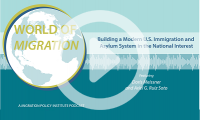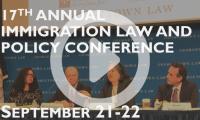Family Reunification
Recent Activity
Marking the launch of MPI’s Global Skills and Talent Initiative, this webcast features senior policymakers and other experts discussing the extent to which labor market needs should shape future immigration policy decisions, and how countries are adjusting—and could adjust—their immigration systems to meet human capital and competitiveness needs.

People on all sides of the policy debate largely agree that the U.S. immigration system is broken. What should a 21st century system that works in the national interest look like? And is this vision achievable amid current political realities?

This year’s Immigration Law and Policy Conference examines the immigration policy agenda under the Trump administration, including changes in the asylum system; the vast societal upheaval brought on by COVID-19 and the rising racial justice movement; what the future of U.S. immigration may look like; and many other topics related to U.S. immigration policy.

This webinar highlights findings from an MPI report examining the potential impacts of expected changes to the public charge rule by the Trump administration. Leaked draft versions suggest the rule could sharply expand the number of legally present noncitizens facing difficulty getting a green card or extending a visa as a result of their family's use of public benefits. The rule likely would discourage millions from accessing health, nutrition, and social services for which they or their U.S.-citizen dependents are eligible.

How does U.S. policy on family migration compare to that of other significant immigrant-receiving countries? MPI experts discuss the trends and policies for Australia, Canada, France, Germany, Italy, the Netherlands, Sweden, and the United Kingdom.




















Regional Processing Centers: Can This Key Component of the Post-Title 42 U.S. Strategy Work?
The Los Angeles Declaration Could Represent a Big Step for Real Migration Cooperation across the Americas
Beyond the Border: Opportunities for Managing Regional Migration between Central and North America
Is Europe Prepared for a Possible Large-Scale Ukrainian Displacement Crisis?
Hampered by the Pandemic: Unaccompanied Child Arrivals Increase as Earlier Preparedness Shortfalls Limit the Response
USCIS Budget Implosion Owes to Far More than the Pandemic
Health Insurance Test for Green-Card Applicants Could Sharply Cut Future U.S. Legal Immigration
Through the Back Door: Remaking the Immigration System via the Expected “Public-Charge” Rule
A Path to Citizenship for 1.8 Million DREAMERs? Despite Talk, No Proposal Would Do So
The Trump Immigration Plan: A Lopsided Proposal
Pages